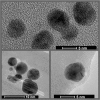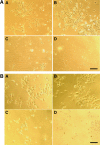Synthesis, characterization and evaluation of antimicrobial and cytotoxic activities of biogenic silver nanoparticles synthesized from Streptomyces xinghaiensis OF1 strain
- PMID: 29305718
- PMCID: PMC5756267
- DOI: 10.1007/s11274-017-2406-3
Synthesis, characterization and evaluation of antimicrobial and cytotoxic activities of biogenic silver nanoparticles synthesized from Streptomyces xinghaiensis OF1 strain
Abstract
We report synthesis of silver nanoparticles (AgNPs) from Streptomyces xinghaiensis OF1 strain, which were characterised by UV-Vis and Fourier transform infrared spectroscopy, Zeta sizer, Nano tracking analyser, and Transmission electron microscopy. The antimicrobial activity of AgNPs alone, and in combination with antibiotics was evaluated against bacteria, namely Escherichia coli, Pseudomonas aeruginosa, Staphylococcus aureus and Bacillus subtilis, and yeasts viz., Candida albicans and Malassezia furfur by using micro-dilution method. The minimum inhibitory concentration (MIC) and minimum biocidal concentration of AgNPs against bacterial and yeast strains were determined. Synergistic effect of AgNPs in combination with antibacterial and antifungal antibiotics was determined by FIC index. In addition, MTT assay was performed to study cytotoxicity of AgNPs alone and in combination with antibiotics against mouse fibroblasts and HeLa cell line. Biogenic AgNPs were stable, spherical, small, polydispersed and capped with organic compounds. The variable antimicrobial activity of AgNPs was observed against tested bacteria and yeasts. The lowest MIC (16 µg ml-1) of AgNPs was found against P. aeruginosa, followed by C. albicans and M. furfur (both 32 µg ml-1), B. subtilis and E. coli (both 64 µg ml-1), and then S. aureus and Klebsiella pneumoniae (256 µg ml-1). The high synergistic effect of antibiotics in combination with AgNPs against tested strains was found. The in vitro cytotoxicity of AgNPs against mouse fibroblasts and cancer HeLa cell lines revealed a dose dependent potential. The IC50 value of AgNPs was found in concentrations of 4 and 3.8 µg ml-1, respectively. Combination of AgNPs and antibiotics significantly decreased concentrations of both antimicrobials used and retained their high antibacterial and antifungal activity. The synthesis of AgNPs using S. xinghaiensis OF1 strain is an eco-friendly, cheap and nontoxic method. The antimicrobial activity of AgNPs could result from their small size. Remarkable synergistic effect of antibiotics and AgNPs offer their valuable potential in nanomedicine for clinical application as a combined therapy in the future.
Keywords: Antibacterial activity; Antifungal activity; Antimicrobials; Biogenic silver nanoparticles; Cytotoxicity; Streptomycetes; Synergism.
Conflict of interest statement
Conflict of interest
All authors declare that they have no conflict of interest.
Ethical approval
This article does not contain any studies with human participants or animals performed by any of the authors.
Informed consent
Informed consent was obtained from all individual participants included in the study.
Figures









Similar articles
-
Antimicrobial and cytotoxic activity of silver nanoparticles synthesized from two haloalkaliphilic actinobacterial strains alone and in combination with antibiotics.J Appl Microbiol. 2018 Jun;124(6):1411-1424. doi: 10.1111/jam.13723. Epub 2018 Mar 23. J Appl Microbiol. 2018. PMID: 29427473
-
Synthesis of silver nanoparticles from two acidophilic strains of Pilimelia columellifera subsp. pallida and their antibacterial activities.J Basic Microbiol. 2016 May;56(5):541-56. doi: 10.1002/jobm.201500516. Epub 2015 Dec 21. J Basic Microbiol. 2016. PMID: 27151174
-
Silver nanoparticles from Pilimelia columellifera subsp. pallida SL19 strain demonstrated antifungal activity against fungi causing superficial mycoses.J Basic Microbiol. 2017 Sep;57(9):793-800. doi: 10.1002/jobm.201700121. Epub 2017 Jul 3. J Basic Microbiol. 2017. PMID: 28670763
-
Biogenic biocompatible silver nanoparticles: a promising antibacterial agent.Biotechnol Genet Eng Rev. 2024 Dec;40(4):3113-3147. doi: 10.1080/02648725.2022.2106084. Epub 2022 Aug 2. Biotechnol Genet Eng Rev. 2024. PMID: 35915981 Review.
-
Nanocomposites: silver nanoparticles and bacteriocins obtained from lactic acid bacteria against multidrug-resistant Escherichia coli and Staphylococcus aureus.World J Microbiol Biotechnol. 2024 Oct 3;40(11):341. doi: 10.1007/s11274-024-04151-3. World J Microbiol Biotechnol. 2024. PMID: 39358621 Review.
Cited by
-
Microalga Broths Synthesize Antibacterial and Non-Cytotoxic Silver Nanoparticles Showing Synergy with Antibiotics and Bacterial ROS Induction and Can Be Reused for Successive AgNP Batches.Int J Mol Sci. 2023 Nov 10;24(22):16183. doi: 10.3390/ijms242216183. Int J Mol Sci. 2023. PMID: 38003373 Free PMC article.
-
Silver Nanoparticle-Based Therapy: Can It Be Useful to Combat Multi-Drug Resistant Bacteria?Antibiotics (Basel). 2022 Sep 6;11(9):1205. doi: 10.3390/antibiotics11091205. Antibiotics (Basel). 2022. PMID: 36139984 Free PMC article. Review.
-
Biosynthesis of Silver Nanoparticles by Marine Actinobacterium Nocardiopsis dassonvillei and Exploring Their Therapeutic Potentials.Front Microbiol. 2022 Feb 3;12:705673. doi: 10.3389/fmicb.2021.705673. eCollection 2021. Front Microbiol. 2022. PMID: 35211096 Free PMC article.
-
In Vitro Antioxidant, Antitumor and Photocatalytic Activities of Silver Nanoparticles Synthesized Using Equisetum Species: A Green Approach.Molecules. 2021 Dec 2;26(23):7325. doi: 10.3390/molecules26237325. Molecules. 2021. PMID: 34885906 Free PMC article.
-
Mycosynthesis of silver nanoparticles from endophytic Aspergillus flavipes AUMC 15772: ovat-statistical optimization, characterization and biological activities.Microb Cell Fact. 2023 Nov 6;22(1):228. doi: 10.1186/s12934-023-02238-4. Microb Cell Fact. 2023. PMID: 37932769 Free PMC article.
References
-
- Atlas RM. Handbook of microbiological media. 4. Boston: CRC Press; 2010.
MeSH terms
Substances
Grants and funding
LinkOut - more resources
Full Text Sources
Other Literature Sources
Molecular Biology Databases

